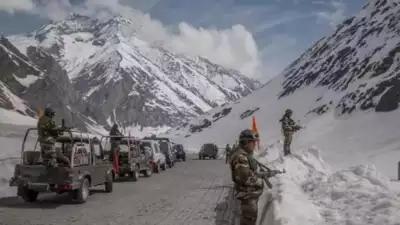Indian troops have commenced patrols in Ladakh’s Demchok sector, following an agreement on disengagement between India and China. The move is aimed at fostering stability along the Line of Actual Control and is part of a coordinated effort to maintain peace in the region.

X/ File Pic
Key Highlights
- Indian troops patrol Demchok after disengagement with China.
- Coordinated efforts aim for stability along the LAC.
- Step-by-step strategy to reduce border tensions underway.
Following the recent disengagement between India and China, Indian troops have begun patrolling the Demchok sector in eastern Ladakh. This development is part of a coordinated approach agreed upon by the two nations to monitor the Line of Actual Control (LAC) within their respective perceptions in both the Demchok and Depsang sectors.
ADVERTISEMENT
Indian Army sources confirmed that patrolling in the Demchok sector has already commenced, while patrols in the Depsang area are expected to start soon. The new arrangements aim for both nations to have mutual awareness of patrol schedules, ensuring coordinated patrols to maintain stability.
The two sides have also exchanged pleasantries as a gesture of goodwill. On Thursday, in celebration of Diwali, Indian and Chinese armies participated in a traditional exchange of sweets at several border locations in Ladakh, including Hot Springs, Karakoram Pass, Daulat Beg Oldi, Kongka La, and the Chushul-Moldo meeting point.
MP Haji Hanifa, representing Ladakh, welcomed the disengagement and expressed hope for a peaceful resolution to the longstanding tensions along the LAC. “Those of us who live near the border understand the impact of conflict. We welcome this agreement, and we hope to see its positive effects implemented on the ground. Tensions should be addressed through diplomatic channels,” MP Hanifa stated.
This sentiment of gradual reconciliation is echoed by Chief of Army Staff, General Upendra Dwivedi, who emphasised that restoring trust along the LAC will be a step-by-step process. According to General Dwivedi, returning to the status quo as of April 2020 will involve phased measures, including disengagement, de-escalation, and buffer zone management, all aimed at reducing tensions in the long term.
Chinese Ambassador to India Xu Feihong has also commented on the matter, acknowledging that, as neighbouring countries, India and China may naturally have differences. However, he highlighted the importance of managing and resolving these issues constructively.
The standoff along the India-China border, which began in 2020, has been a point of significant tension between the two countries. The initial conflict in eastern Ladakh was attributed to Chinese military advances along the LAC, straining bilateral relations and sparking a series of confrontations that persisted for months. Since then, both nations have engaged in multiple rounds of diplomatic and military talks to ease the situation and work towards a peaceful resolution.
The recent agreement on coordinated patrols is a hopeful sign for reduced hostilities and improved cooperation along the LAC, where a carefully planned, phase-wise approach may provide a foundation for longer-term peace and stability in the region.
(With inputs from ANI)
 Subscribe today by clicking the link and stay updated with the latest news!" Click here!
Subscribe today by clicking the link and stay updated with the latest news!" Click here!







